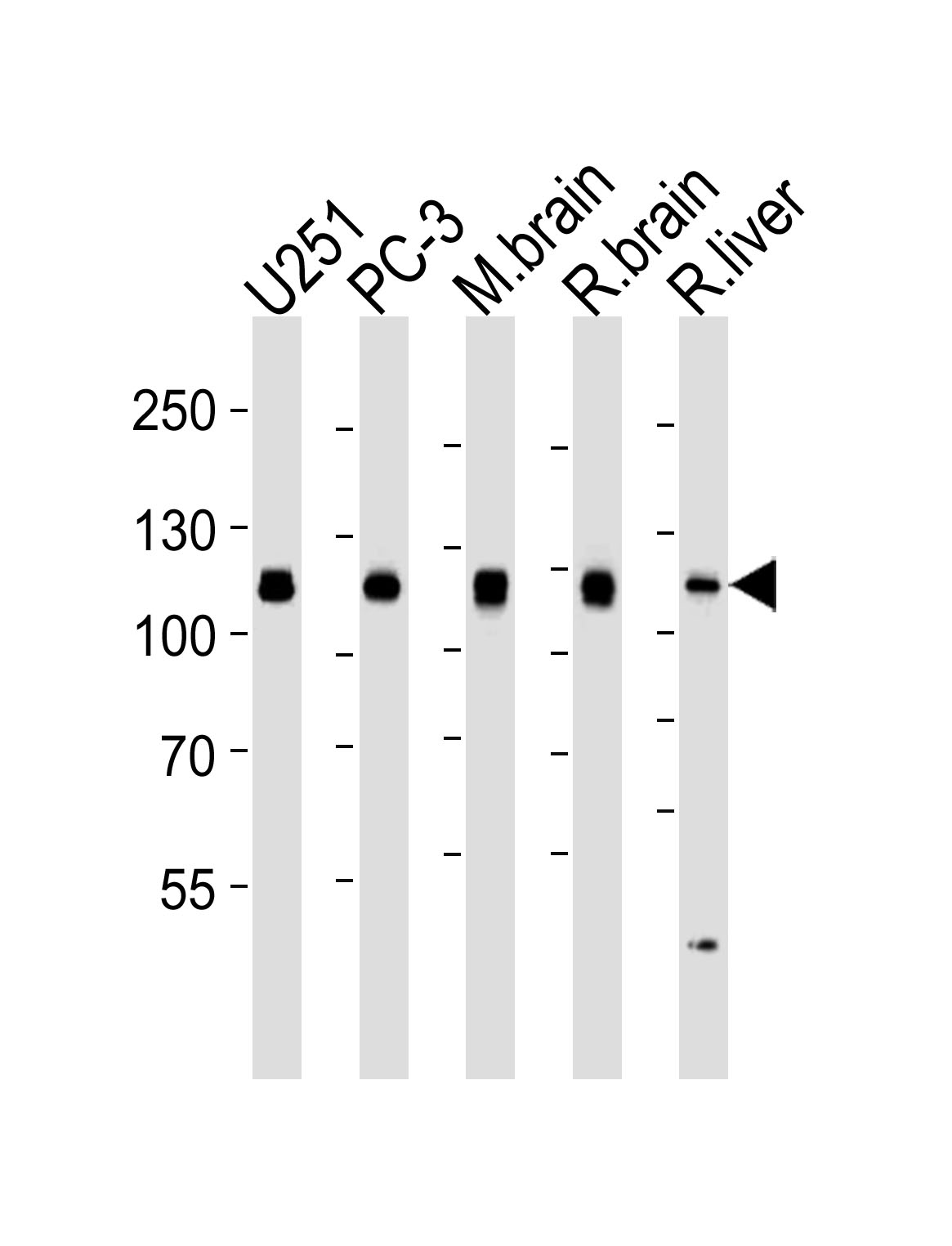USP5 Antibody
Purified Mouse Monoclonal Antibody (Mab)
- SPECIFICATION
- CITATIONS
- PROTOCOLS
- BACKGROUND

Application
| WB, E |
|---|---|
| Primary Accession | P45974 |
| Reactivity | Human, Mouse, Rat |
| Host | Mouse |
| Clonality | Monoclonal |
| Isotype | IgG1,κ |
| Clone/Animal Names | 1340CT704.170.140 |
| Calculated MW | 95786 Da |
| Gene ID | 8078 |
|---|---|
| Other Names | Ubiquitin carboxyl-terminal hydrolase 5, Deubiquitinating enzyme 5, Isopeptidase T, Ubiquitin thioesterase 5, Ubiquitin-specific-processing protease 5, USP5, ISOT |
| Target/Specificity | This USP5 antibody is generated from a mouse immunized with a recombination protein from the human region of human USP5. |
| Dilution | WB~~1:2000 E~~Use at an assay dependent concentration. |
| Format | Purified monoclonal antibody supplied in PBS with 0.09% (W/V) sodium azide. This antibody is purified through a protein G column, followed by dialysis against PBS. |
| Storage | Maintain refrigerated at 2-8°C for up to 2 weeks. For long term storage store at -20°C in small aliquots to prevent freeze-thaw cycles. |
| Precautions | USP5 Antibody is for research use only and not for use in diagnostic or therapeutic procedures. |
| Name | USP5 |
|---|---|
| Synonyms | ISOT |
| Function | Deubiquitinating enzyme that participates in a wide range of cellular processes by specifically cleaving isopeptide bonds between ubiquitin and substrate proteins or ubiquitin itself. Affects thereby important cellular signaling pathways such as NF-kappa-B, Wnt/beta- catenin, and cytokine production by regulating ubiquitin-dependent protein degradation. Participates in the activation of the Wnt signaling pathway by promoting FOXM1 deubiquitination and stabilization that induces the recruitment of beta-catenin to Wnt target gene promoter (PubMed:26912724). Regulates the assembly and disassembly of heat-induced stress granules by mediating the hydrolysis of unanchored ubiquitin chains (PubMed:29567855). Promotes lipopolysaccharide-induced apoptosis and inflammatory response by stabilizing the TXNIP protein (PubMed:37534934). Affects T-cell biology by stabilizing the inhibitory receptor on T-cells PDC1 (PubMed:37208329). Acts as a negative regulator of autophagy by regulating ULK1 at both protein and mRNA levels (PubMed:37607937). Acts also as a negative regulator of type I interferon production by simultaneously removing both 'Lys-48'-linked unanchored and 'Lys-63'-linked anchored polyubiquitin chains on the transcription factor IRF3 (PubMed:39761299). Modulates the stability of DNA mismatch repair protein MLH1 and counteracts the effect of the ubiquitin ligase UBR4 (PubMed:39032648). Upon activation by insulin, it gets phosphorylated through mTORC1-mediated phosphorylation to enhance YTHDF1 stability by removing 'Lys-11'-linked polyubiquitination (PubMed:39900921). May also deubiquitinate other substrates such as the calcium channel CACNA1H (By similarity). |
| Cellular Location | Cytoplasm. Cytoplasm, Stress granule. Nucleus |

Thousands of laboratories across the world have published research that depended on the performance of antibodies from Abcepta to advance their research. Check out links to articles that cite our products in major peer-reviewed journals, organized by research category.
info@abcepta.com, and receive a free "I Love Antibodies" mug.
Provided below are standard protocols that you may find useful for product applications.
Background
Cleaves linear and branched multiubiquitin polymers with a marked preference for branched polymers. Involved in unanchored 'Lys-48'-linked polyubiquitin disassembly. Binds linear and 'Lys- 63'-linked polyubiquitin with a lower affinity. Knock-down of USP5 causes the accumulation of p53/TP53 and an increase in p53/TP53 transcriptional activity because the unanchored polyubiquitin that accumulates is able to compete with ubiquitinated p53/TP53 but not with MDM2 for proteasomal recognition.
References
Falquet L.,et al.FEBS Lett. 376:233-237(1995).
Ansari-Lari M.A.,et al.Genome Res. 6:314-326(1996).
Ansari-Lari M.A.,et al.Genome Res. 7:268-280(1997).
Tashayev V.L.,et al.Submitted (NOV-1995) to the EMBL/GenBank/DDBJ databases.
Mural R.J.,et al.Submitted (SEP-2005) to the EMBL/GenBank/DDBJ databases.
If you have used an Abcepta product and would like to share how it has performed, please click on the "Submit Review" button and provide the requested information. Our staff will examine and post your review and contact you if needed.
If you have any additional inquiries please email technical services at tech@abcepta.com.













 Foundational characteristics of cancer include proliferation, angiogenesis, migration, evasion of apoptosis, and cellular immortality. Find key markers for these cellular processes and antibodies to detect them.
Foundational characteristics of cancer include proliferation, angiogenesis, migration, evasion of apoptosis, and cellular immortality. Find key markers for these cellular processes and antibodies to detect them. The SUMOplot™ Analysis Program predicts and scores sumoylation sites in your protein. SUMOylation is a post-translational modification involved in various cellular processes, such as nuclear-cytosolic transport, transcriptional regulation, apoptosis, protein stability, response to stress, and progression through the cell cycle.
The SUMOplot™ Analysis Program predicts and scores sumoylation sites in your protein. SUMOylation is a post-translational modification involved in various cellular processes, such as nuclear-cytosolic transport, transcriptional regulation, apoptosis, protein stability, response to stress, and progression through the cell cycle. The Autophagy Receptor Motif Plotter predicts and scores autophagy receptor binding sites in your protein. Identifying proteins connected to this pathway is critical to understanding the role of autophagy in physiological as well as pathological processes such as development, differentiation, neurodegenerative diseases, stress, infection, and cancer.
The Autophagy Receptor Motif Plotter predicts and scores autophagy receptor binding sites in your protein. Identifying proteins connected to this pathway is critical to understanding the role of autophagy in physiological as well as pathological processes such as development, differentiation, neurodegenerative diseases, stress, infection, and cancer.


